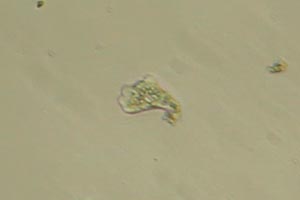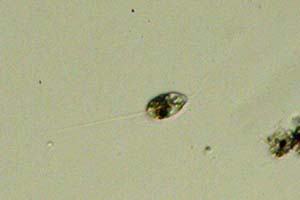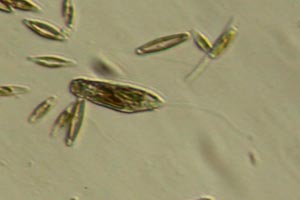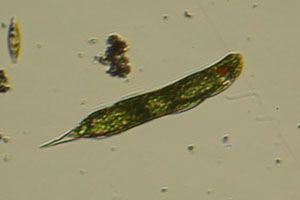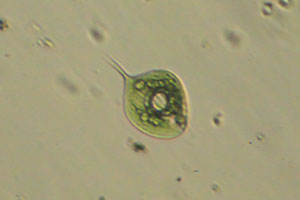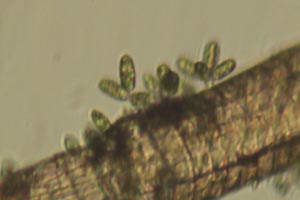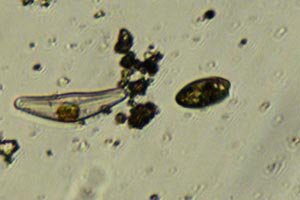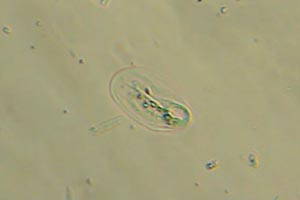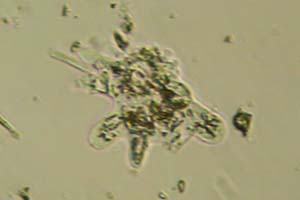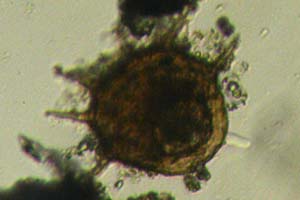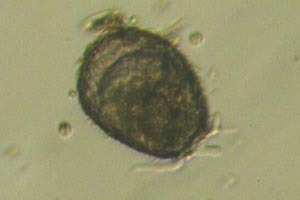Protozoa are ancestral to the other eukaryote kingdoms rather than a complete evolutionary group in themselves. Traditionally most single-celled organisms that feed by ingestion were placed here, but many of the best-known belong with the Chromista, leaving a somewhat heterogeneous collection of groups that do not fit anywhere else.
Percolozoa are one of several excavate groups, where flagella when present are typically associated with a feeding groove. They are distinguished by features like the form of mitochondria.
Heterolobosea
Greek heteros, different, lobos, lobe
These are mainly small protozoa that transform between flagellates in rapid movement, and amoebae in feeding. However some only have one form or the other.
The amoebae are eruptive, moving through rapid bursts along the front margin. This separates them from other groups which move by continuous streaming.
Euglenozoa are a large group of flagellates that share a common cell structure with 1-4 flagella containing internal rods, which arise from a depression and are often associated with a mouth. However, these features are not apparent in many smaller types, which are mostly bacterivores or endosymbionts.
Euglenoids include some more conspicuous kinds, most common in nutrient-rich water. Their flagella are set in an anterior reservoir, and their outer membrane is supported by longitudinal strips, forming a pellicle that helps them maintain or change their shape. Different types feed by ingestion, absorption, or photosynthesis.
Phagotrophic euglenoids usually have feeding rods to help them ingest food such as bacteria, other euglenoids and algae, or dead material. They often have one leading and one trailing flagellum, with different types using one or the other to glide over surfaces.
Anisonema
Greek anisos, unequal, nēma, thread
Angl. a-NYE-so-NEE-ma
Anisonema are oval with a deep reservoir behind the front. The trailing flagellum runs back through a furrow and well past the cell, so that it can quickly pull back and change direction.
Peranemidae
Greek pēra, pouch, nēma, thread
Angl. PER-a-NEM-i-dee
Peranemids have a stiff leading flagellum, held forwards and beating only near the tip. The other one is absent or fused to the cell, which is plastic in form.
In different types the front end is pointed, in which case the back end is generally rounded, or has an unusual flared rim.
Photosynthetic euglenoids are mostly bright green, with small chloroplasts originally taken from green algae and a red eyespot near the flagella. Most belong to the Euglenida, where only one flagellum extends out of the reservoir. This undergoes a looping motion, pulling them along a slightly helical path.
Lepocinclis
Greek lepos, rind, kigklis, lattice
Angl. LEP-o-SINK-lis
Lepocinclis are ovoid to long with small plastids and a sharp posterior spine. The pellicle may be capable of bending but not deforming and often has prominent helical grooves.
Phacus
Greek phakos, lentil
Angl. FAY-kus
Phacus are mostly broad and leaf-shaped with a tail spine. Such cells are either flattened or divided into thin lobes, often somewhat twisted around the main axis.
Euglena
Greek eus, good, glēnē, eyeball
Angl. yoo-GLEE-na
Euglena have a deformable pellicle allowing metaboly, a slow creeping movement by worm-like contractions. They are mainly distinguished by plastid or molecular features.
These vary in size and form, and some have blunt or acute ends without the tapering point typical of similar genera. There are also some that become red in certain conditions.
Colacium
Greek kolax, flatterer, -ion, dimn.
Angl. ko-LAY-seeum
Colacium live attached to small crustaceans or other objects, most forming branching colonies with relatively thick stalks. The cells are oval with an eyespot near the base.
Trachelomonas
Greek trachēlos, neck, monas, unit
Angl. TRAK-e-LOM-o-nas
Trachelomonas are enclosed by a protective lorica, which is rounded or spiny and usually brownish. This has a small opening for the flagellum, often with a short but distinct collar.
These mainly include the cryptomonads, small cells with two flagella inserted on the edge of a groove or pocket. Each has one or two plastids, which may have several different colours. These are derived from red algae and unusual in retaining a degenerate nucleus along with starch granules.
Cryptomonas
Greek kryptos, hidden, monas, unit
Angl. krip-TOM-o-nas
Cryptomonas have an oblique front with a pocket or gullet. They are yellow-green to brown when photosynthetic, but also include colourless kinds that feed by absorption.
Amoebozoa generally move by internal flow of the cell body, which happens more or less continuously, rather than through eruptions or fine projections. They have no constant shape, but most have a fairly characteristic type of form during directed movement. Many of the largest protozoa, like slime molds, belong here.
Discosea are flattened amoebae that move as a whole, advancing along a single front or pseudopodium with a clear margin. Some also have more or less pointed sub-pseudopodia, small projections that are not directly involved in movement, or a protective coating.
Thecamoeba
Greek thēkē, case, amoibē, change
Angl. THEE-ka-MEE-ba
Thecamoeba are longer than wide and have a thickened coat. This is reflected by dorsal folds, either in parallel ridges running along the back or as irregular wrinkles in larger types.
Tubulinea are typically amoebae that move using blunt projections, called lobopodia. Smaller kinds are usually cylindrical but may spread out during feeding. Larger ones have multiple lobopodia, and often form protective shells from various secretions or collected debris.
Polychaos
Greek polys, much or many, chaos, unformed mass
Angl. po-LIK-ay-os
Polychaos are mainly short and palmate with a number of lobopodia of similar size. These can flow together as the cell moves, unlike relatives where all but one eventually retract.
Centropyxis
Greek kentron, sharp point, pyxis, box
Angl. SEN-tro-PIK-sis
Centropyxis make wedge-shaped shells with both secreted and collected material. The opening is set near the front and they often have several spines along the back margin.
Netzelia
After Harald Netzel, published c. 1970s
Angl. net-ZEE-leea
Netzelia have granular shells of spherical to ovoid shape. There is a round opening, and often a thickened rim, with a margin of lobes or inward teeth. Some also have several spines.
These often collect mineral particles for their shell, but can also produce fine silicate granules or organic material.
Arcellidae
Latin arca, box, -ella, dimn.
Angl. ar-SEL-i-dee
Arcellids have round cap-shaped shells opening in a central circle. They are made entirely from secreted material, starting out clear and becoming brown and dark as they age.
